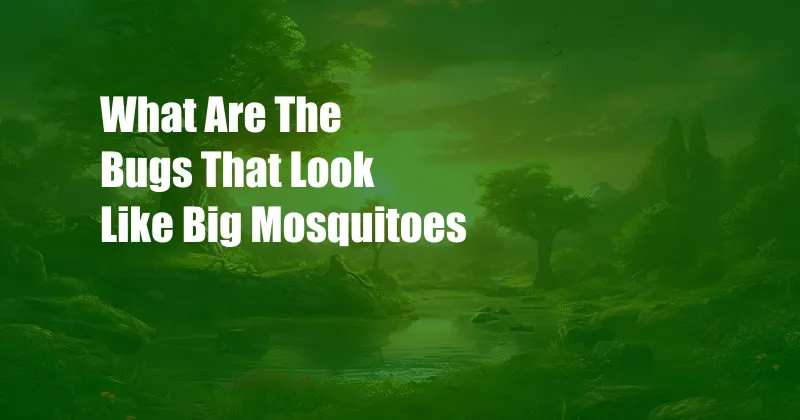
What Are Those Bugs That Look Like Big Mosquitoes?
As the summer season approaches, it’s important to be aware of the various insects that may be lurking around your home or yard. One such insect that can sometimes be mistaken for a mosquito is a crane fly. Crane flies are often referred to as “mosquito hawks” due to their large size and resemblance to mosquitoes. However, despite their similar appearance, crane flies are actually quite different from mosquitoes.
Crane flies are long-legged flies that belong to the family Tipulidae. They are typically brown or gray in color and have a long, slender body with a narrow head. Crane flies have two long, thin wings, and their legs are often very long and spindly. Male crane flies have larger eyes than females, and their antennae are bushier. Crane flies are not known to bite or sting humans, and they do not feed on blood. Instead, adult crane flies primarily feed on nectar and pollen, while the larvae feed on decaying organic matter in the soil.
Crane flies are generally considered to be harmless insects, but they can sometimes be a nuisance due to their sheer numbers. Crane flies are most active during the spring and fall, and they can often be seen flying around in large swarms. While crane flies do not pose any health risks to humans, they can be a nuisance when they get into your home. If you find yourself with a crane fly infestation, there are a few things you can do to get rid of them. First, try to identify and eliminate any sources of standing water around your home, as this is where crane flies lay their eggs. You can also try using a vacuum cleaner to remove crane flies from your home. If you have a large infestation, you may need to contact a pest control company to help you get rid of them.
Crane Fly Larvae
Crane fly larvae are known as “leatherjackets” due to their tough, leathery skin. Leatherjackets are typically white or cream-colored, and they have a long, slender body with a pointed head. Leather jackets have no legs, and they move around by wriggling their bodies. Leather jackets feed on decaying organic matter in the soil, and they can sometimes damage lawns and gardens. If you have a problem with leather jackets, you can try using a variety of methods to get rid of them. One common method is to apply a milky spore powder to your lawn. Milky spore powder is a bacteria that infects leather jackets and kills them. You can also try using nematodes to get rid of leather jackets. Nematodes are microscopic worms that attack and kill leather jackets. If you have a large infestation of leather jackets, you may need to contact a pest control company to help you get rid of them.
Tips for Avoiding Crane Flies
There are a few things you can do to help avoid crane flies around your home. First, try to eliminate any sources of standing water around your home, as this is where crane flies lay their eggs. You can also try to keep your lawn mowed and free of weeds, as this will make it less attractive to crane flies. Finally, you can try to seal up any cracks or holes in your home’s foundation, as this will help to prevent crane flies from getting inside.
Expert Advice
If you are having a problem with crane flies, there are a few things you can do to get rid of them. First, try to identify and eliminate any sources of standing water around your home, as this is where crane flies lay their eggs. You can also try using a vacuum cleaner to remove crane flies from your home. If you have a large infestation, you may need to contact a pest control company to help you get rid of them.
FAQ
-
What are crane flies?
Crane flies are long-legged flies that belong to the family Tipulidae. They are typically brown or gray in color and have a long, slender body with a narrow head. -
Are crane flies harmful?
No, crane flies are not harmful to humans. They do not bite or sting, and they do not feed on blood. -
What do crane flies eat?
Adult crane flies primarily feed on nectar and pollen, while the larvae feed on decaying organic matter in the soil. -
How can I get rid of crane flies?
There are a few things you can do to get rid of crane flies. First, try to identify and eliminate any sources of standing water around your home, as this is where crane flies lay their eggs. You can also try using a vacuum cleaner to remove crane flies from your home. If you have a large infestation, you may need to contact a pest control company to help you get rid of them.
Conclusion
Crane flies are common insects that can sometimes be a nuisance, but they are not harmful to humans. If you are having a problem with crane flies, there are a few things you can do to get rid of them. By following the tips and advice in this article, you can help to keep your home free of crane flies.
Are you interested in learning more about crane flies? If so, there are a number of resources available online that can provide you with additional information.